11 Ways to Become a Better Blogger, According to the HubSpot Blog Team
1. Develop and leverage a network of experts.

Jay Fuchs — this article's curator, HubSpot Sales Blog editor, and guy currently writing in third-person — says:
"Firsthand experience and expertise are mission-critical in the context of E-E-A-T — the fact that the first two 'E's' in that acronym literally stand for 'Experience' and 'Expertise' is a clever, little nod to that. You need expert perspectives, and if you can‘t offer that kind of insight, it’s important you develop a network of people who can.
"Take the time to foster relationships with bonafide players in the fields you write about. You can get there through means like LinkedIn outreach, social media forums, personal connections, or resources like Featured.com (a legitimate godsend for bloggers).
“Once you've sourced those experts, tap them for quotes or have them check your work to ensure it's accurate. The most effective blog content is crafted with expert backing. If you don't have it yourself, you need to have a network of SMEs who you can lean on.”
2. Get a feedback buddy.
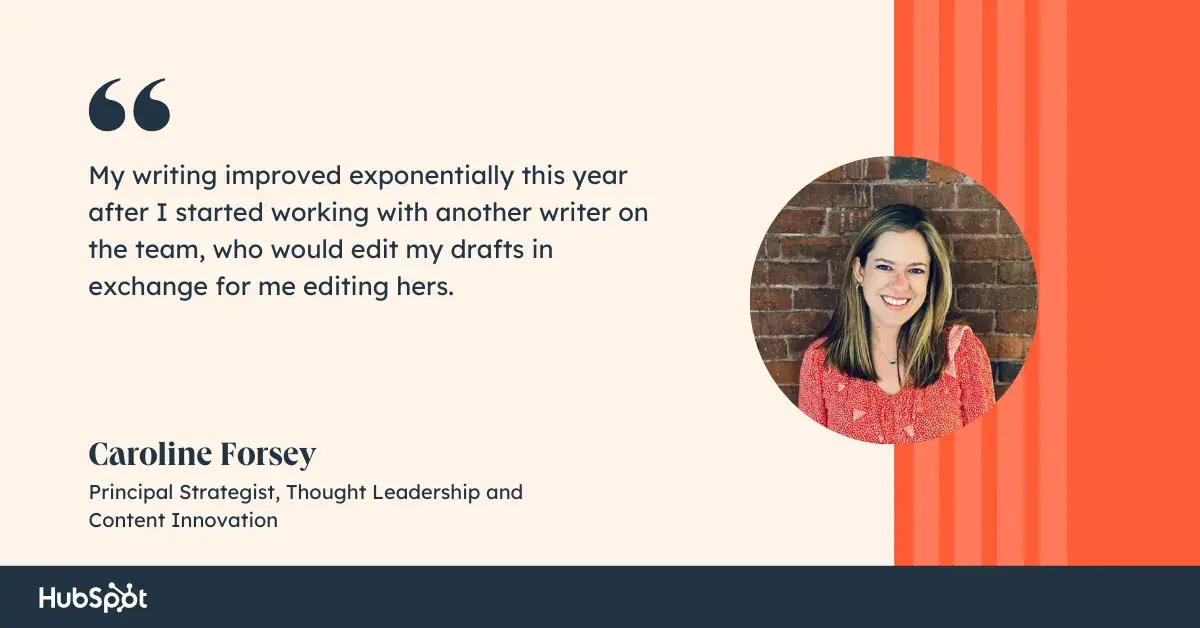
Caroline Forsey — HubSpot's resident thought leadership guru — says:
"My number one tip after blogging for the HubSpot Marketing Blog for seven years is this: Get a feedback buddy! My writing improved exponentially this year after I started working with another writer on the team, who would edit my drafts in exchange for me editing hers. It sounds silly or simple but another set of eyes really illuminated some areas of growth for me.
3. Be specific and non-jargon-y.
Forsey also says:
"As a ‘bonus’ tip, some big things I‘ve learned are that specificity always makes something more interesting and to avoid jargon at all costs. So rather than saying ’One social media strategy increased our ROI by 15%,' (did you just zone out like I did?), you might say, 'Trying out silly dances on TikTok got our follower count up by 15%."
4. Always have outside support for your claims.

Ramona Sukhraj — Principal Writer for The HubSpot Marketing Blog — says:
"Never rest on just your laurels. No matter how much expertise or experience I have on a topic I am writing about, I always seek outside sources to support the ideas I present. Maybe that’s a quote from another thought leader, scientific research, survey data, or even an industry example.
"The point is to establish credibility and drive home the reliability of the information being shared. Because here’s the thing: At the end of the day, business bloggers are marketers. We’re trying to sell something and we can’t expect our audience to mindlessly accept whatever we tell them, especially if they’re discovering us for the first time.
“Sharing real-world support of your claims instills that you know what you’re talking about and you’re worth listening to.”
5. Taking a break makes you a better editor.
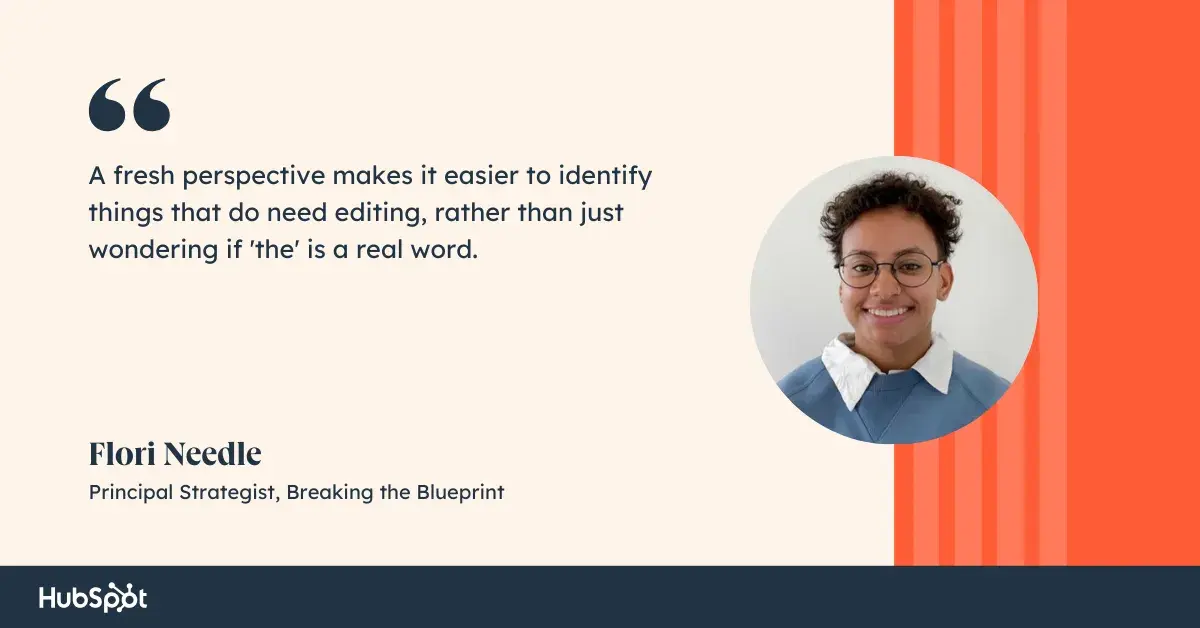
Flori Needle — the force behind HubSpot's Breaking the Blueprint program — says:
"I self-edit everything I write for the HubSpot Blog. I probably read and edit between 2-4K words per week. Sometimes, I spend so much time editing a piece that it sounds like alphabet soup. Everything morphs into a run-on sentence, comma placement is nonsensical, and words are out of place.
"If I reach that point, I take it as a sign to step away, reset, and give myself a chance to come back with fresh eyes. I’ll work on something else for a few hours; sometimes, I won’t even look at the piece for a few days. I basically put my writing in time-out.
“When I get back to it, I realize I’m not a bad writer after all. Sentences behave themselves, commas are in the right place, and my words form into logical statements. A fresh perspective also makes it easier to identify things that do need editing, rather than just wondering if 'the' is a real word.”
6. Pick a real person and write to them.
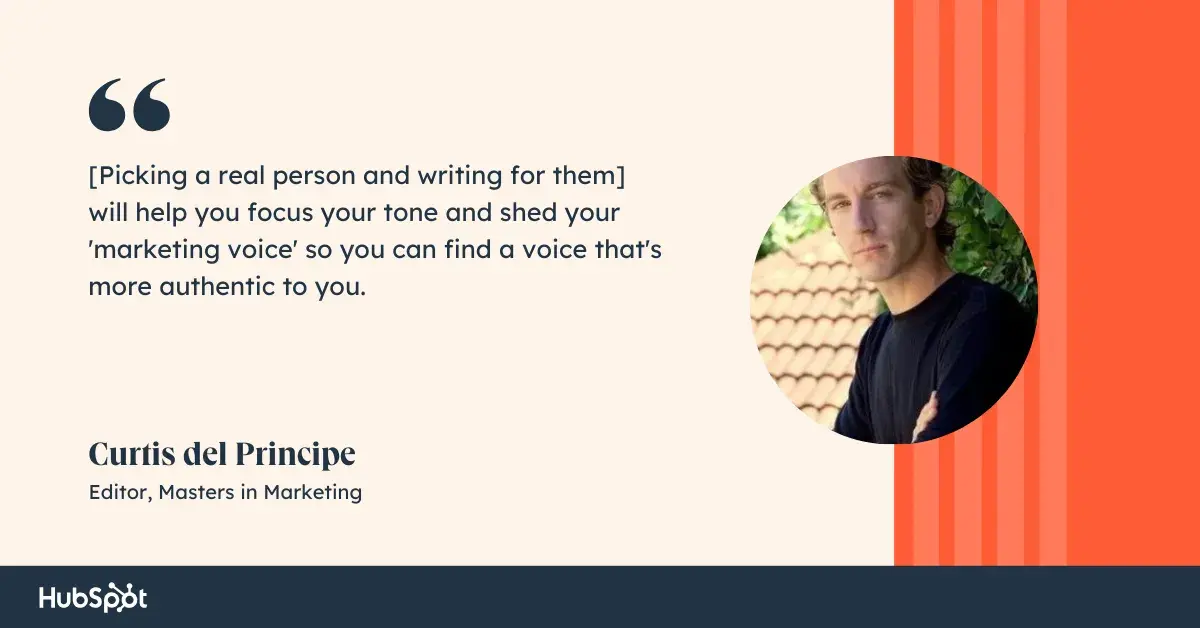
Curt del Principe — Masters in Marketing Editor — says:
"This will help you focus your tone and shed your ‘marketing voice’ so you can find a voice that's more authentic to you.
"For example, when I want to write something fun, I write it to my friend Ken. I know he'll catch all my 90s movie references and the song lyrics I often sneak in. (Go ahead and check.) But when I write something more technical, I write it to my dad.
"He didn‘t grow up on the internet, so I do have to explain core concepts — but he was a lifelong engineer, so I don’t have to ‘dumb it down.’ Writing to him helps me be explanatory but not condescending.
7. Emulate your favorite writers.
Curt also says:
"You couldn‘t play a piano concerto until you learned to play basic chords, right? In the same way, you can’t learn to be a great writer until you learn the styles/cadences/word choices that make for great reading.
“Emulating the writers that you love is a good way to build that vocabulary. My favorite writer is David Sedaris, and I'd probably get fired if I went off on long and sometimes cuss-filled tangents like he does. But I can still learn from his self-deprecating humor or his way of making the reader feel in on the joke.”
8. Read your writing out loud.
Curt also also says:
"One of the worst traps for smart writers is writing something that only makes sense in your own head. You know what you mean, right? But if you can‘t read it out loud without stumbling or taking awkward breaths, it’s probably not going to read well to someone who doesn't already know what you mean."
9. Stay informed in your industry.
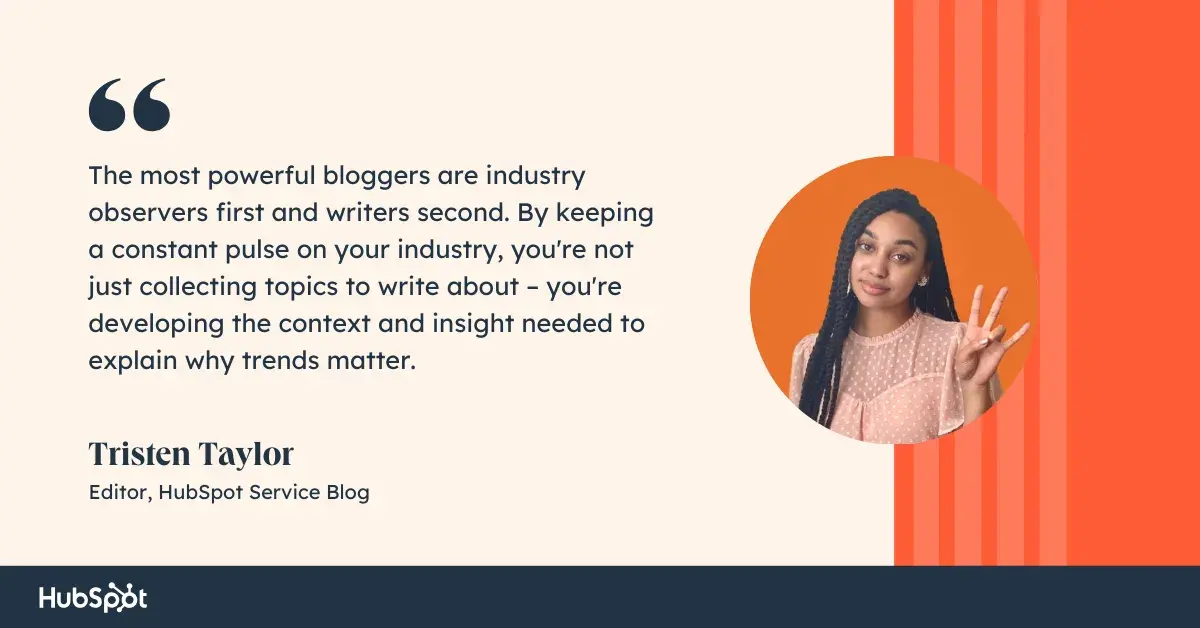
Tristen Taylor — HubSpot Service Blog Editor — says:
"The most powerful bloggers are industry observers first and writers second. By keeping a constant pulse on your industry, you‘re not just collecting topics to write about – you’re developing the context and insight needed to explain why trends matter.
"This deeper understanding helps you spot patterns early, draw meaningful connections between seemingly unrelated developments, and provide your readers with something more valuable than just information: perspective.
“When you truly understand your industry's landscape, your content naturally evolves from simply reporting what's happening to explaining why it matters and where things are headed.”
10. Read more.
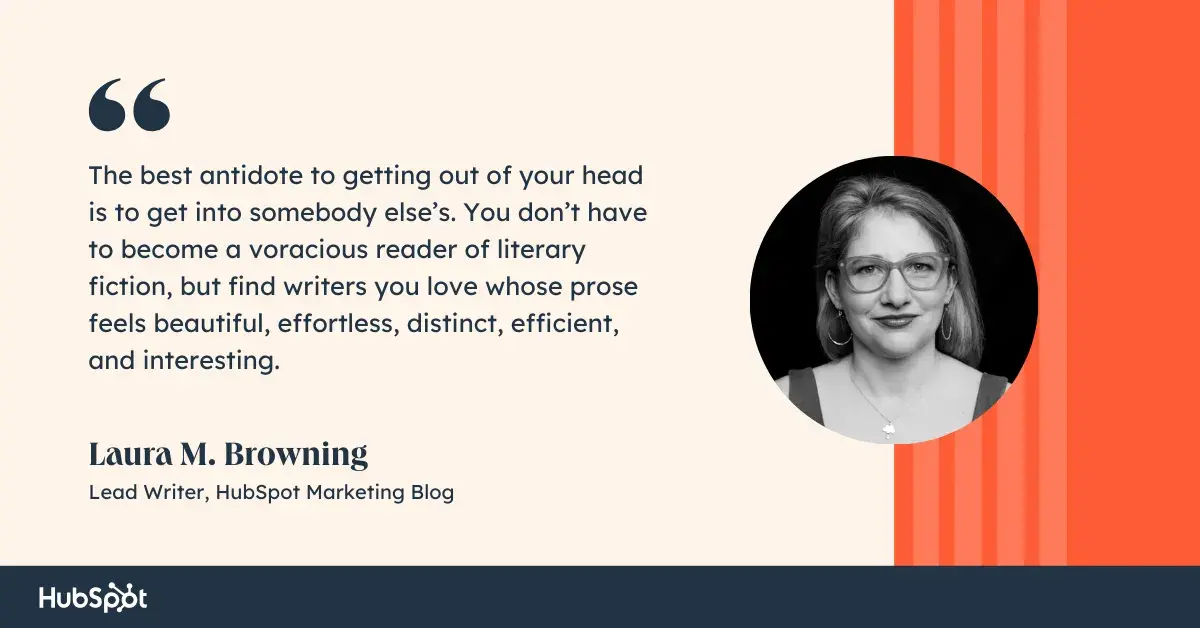
Laura M. Browning — The HubSpot Blog Team's Lead Marketing Writer — says:
"When you’re writing all day, every day, it’s easy to get stuck in your own head. I find myself repeating turns of phrase, recycling my vocabulary, or otherwise getting in a rut.
"The best antidote to getting out of your head is to get into somebody else’s. You don’t have to become a voracious reader of literary fiction, but find writers you love whose prose feels beautiful, effortless, distinct, efficient, and interesting.
“Look for people writing on topics that you love and that aren’t related to your job. It’s the simplest way to build your vocabulary, experiment with sentence structure, learn how to incorporate humor, and become a stronger writer.”
11. Don’t edit while you write.
Browning also says:
"This was a hard lesson for me to learn: I’d get stuck on finding the perfect word and spend five minutes on a single sentence, or I’d get distracted by some quick ('quick') research. I couldn’t separate the writing from the editing.
"My hack: Use ‘TK’s‘ to flag places you need to return to after you’re done writing. (’TK‘ is the phonetic shorthand for ’to come,‘ as in, ’there’s more copy to come as soon as my brain can find the right word.') I also sometimes use brackets to help Future Laura remember something.
“For example: 'Gen Z is changing the way we do marketing, [TK find a stat to use here], TK TK.' This keeps me from falling down a research hole and from spending too much time figuring out how I want to end the sentence. When I’m done writing, I just Ctrl-F for 'TK' — and with the rest of the piece already written, it’s usually much easier for me to fill in the blanks.”
With all that in mind, are you ready to blog harder and better than ever before?
I can only imagine the answer is, “Heck yes, Jay! I have nothing but astonishment and perpetual gratitude for the wisdom you and the rest of the team imparted in this article. Thank you, and bless your precious hearts!”
Wow — that's very flattering. No problem, reader who totally thought that exact statement word-for-word!
Seriously though, we hope that these tips can provide you with some direction in the ever-shifting landscape of content marketing. We want you to thrive. Ideally, the insight we shared here will help your case.
.png?width=112&height=112&name=Image%20Hackathon%20%E2%80%93%20Horizontal%20(67).png)

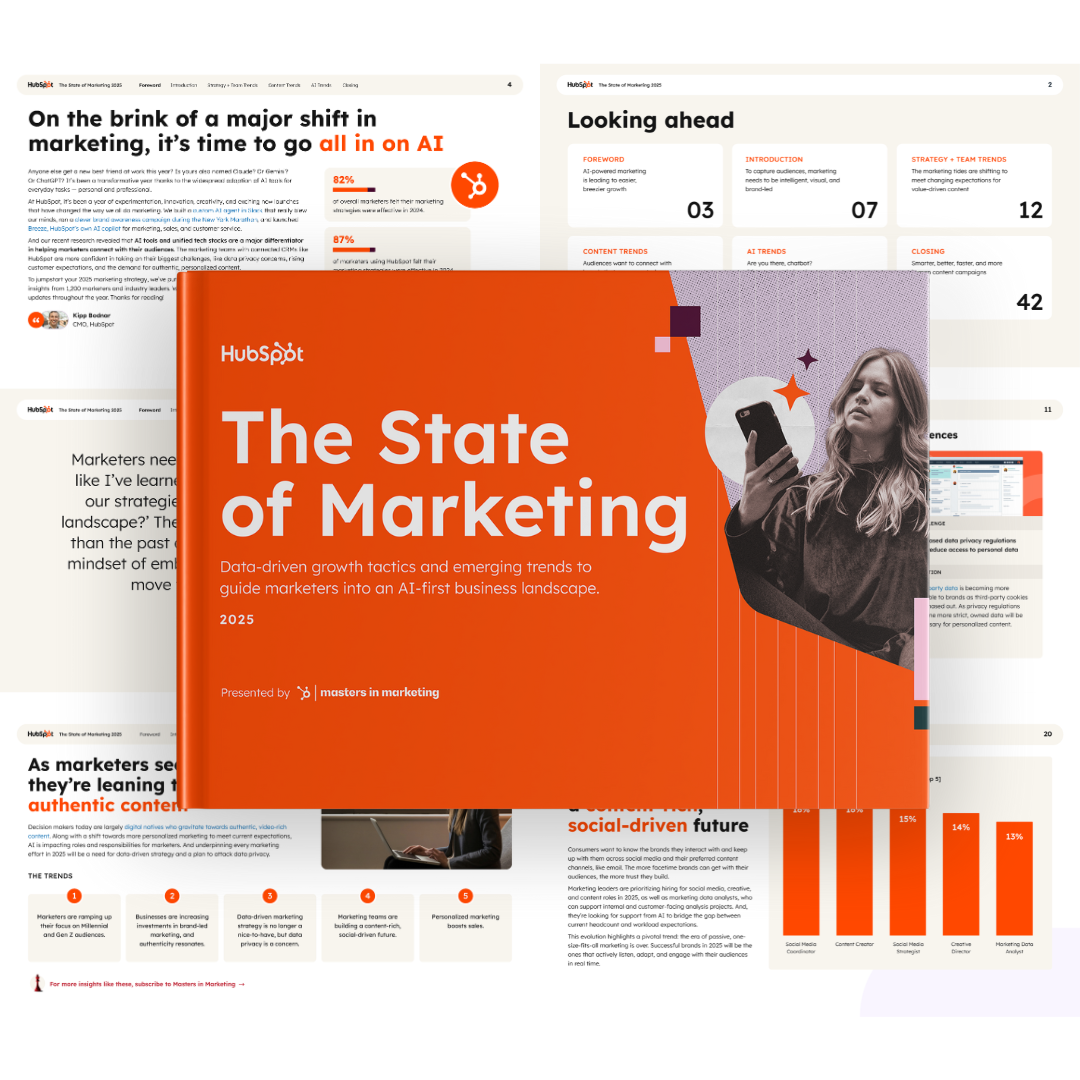

![HubSpot's 2025 State of Blogging Report [Data from 500+ Marketers]](https://53.fs1.hubspotusercontent-na1.net/hubfs/53/untitled-design-4-67880d8b2a3db.webp)





![The Top 3 Reasons Consumers Read Blogs & How to Attract Them [New Data]](https://53.fs1.hubspotusercontent-na1.net/hubfs/53/202_Reasons-Consumers-Read-Blogs.png)

